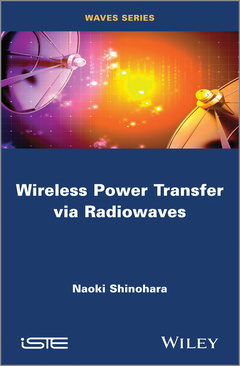Wireless Power Transfer via Radiowaves
Auteur : Shinohara Naoki

Recent advances in Wireless Power Transmission (WPT) technologies have enabled various engineering applications with potential product implementation. WPT can be utilized to charge batteries in various pieces of equipment without the need for a wired connection. Energy can be harvested from ambient RF and microwave radiation and 1 million kW microwaves can be transmitted from space to the ground.
This book covers all the theory and technologies of WPT, such as microwave generators with semi-conductors and microwave tubes, antennas, phased arrays, beam efficiency, and rectifiers (rectenna). The authors also discuss coupling WPT. Applications, such as energy harvesting, sensor networks, point-to-point WPT, WPT to moving targets (airplane, vehicle, etc.) and Solar Power Satellite are also presented.
Introduction ix
Chapter 1. History, Present and Future of WPT 1
1.1. Theoretical predictions and the first trial in the 19th Century 1
1.2. Rejuvenated WPT by microwaves in the 1960s 3
1.3. Inductive coupling WPT projects in the 20th Century 10
1.4. WPT as a game-changing technology in the 21st Century 12
Chapter 2. Theory of WPT 21
2.1. Theoretical background 21
2.2. Beam efficiency and coupling efficiency 22
2.2.1. Beam efficiency of radiowaves 22
2.2.2. Theoretical increase of beam efficiency 26
2.2.3. Coupling efficiency at very close coupling distance 31
2.3. Beam forming 33
2.3.1. Beam-forming theory for the phased array and its error 33
2.3.2. Target detecting via radiowaves 42
2.4. Beam receiving 47
Chapter 3. Technologies of WPT 53
3.1. Introduction 53
3.2. Radio frequency (RF) generation – HPA using semiconductors 56
3.3. RF generation – microwave tubes 62
3.3.1. Magnetrons 63
3.3.2. Traveling wave tube/traveling wave tube amplifier 78
3.3.3. Klystron 80
3.4 Beam-forming and target-detecting technologies with phased array 81
3.4.1. Introduction 81
3.4.2. Phased array in the 1990s 82
3.4.3. Phased array in the 2000s 88
3.4.4. Phased array using magnetrons 98
3.4.5. Retrodirective system 105
3.5. RF rectifier – rectenna and tube type 110
3.5.1. General rectifying theory of rectenna 110
3.5.2. Various rectennas I – rectifying circuits 118
3.5.3. Various rectennas II – higher frequency and dual bands 123
3.5.4. Various rectennas III – weak power and energy harvester 129
3.5.5. Rectenna array 133
3.5.6. Rectifier using vacuum tube 138
Chapter 4. Applications of WPT 143
4.1. Introduction 143
4.2. Energy harvesting 145
4.3. Sensor network 152
4.4. Ubiquitous power source 156
4.5. MPT in a pipe 160
4.6. Microwave buildings 164
4.7. 2D WPT 169
4.8. Wireless charging for electric vehicles 171
4.9. Point-to-point WPT 177
4.10. WPT to moving/flying target 178
4.11. Solar power satellite 185
4.11.1. Basic concept 185
4.11.2. SPS as clean energy source of CO2-free energy and for sustainable humanosphere 187
4.11.3. MPT on SPS. 190
4.11.4. Various SPS models 192
Bibliography 213
Index 237
Naoki Shinohara is Professor at the Research Institute for Sustainable Humanosphere (RISH) at Kyoto University in Japan. His research interests include wireless power transfer, microwave power transfer, and solar power satellites.
Date de parution : 01-2014
Ouvrage de 254 p.
16.3x24.1 cm
